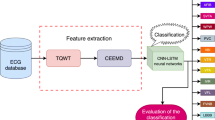Abstract
Arrhythmia denotes to the abnormalities in the rhythm of the heartbeat experienced by individuals. The arrhythmia potentially causes fatal difficulties that lead to the sudden risk to life. Therefore, arrhythmia identification and classification is an important task for cardiac diagnosis. However, inappropriate hyperparameters initialized in the deep learning classifier fail to achieve full potential during the diagnosis. Therefore, this paper proposes an effective hyperparameter optimization using Runge Kutta (RUN) optimizer for a deep learning classifier i.e., Long Short Term Memory (LSTM). The important motivation of this research is to optimize the hyperparameters of LSTM for an effective arrhythmia identification and classification. First, the Electrocardiogram (ECG) signals of MIT-BIH arrhythmia dataset are transformed and decomposed using Multiscale Local Polynomial Transform (MLPT) and Ensemble Empirical Mode Decomposition (EEMD). Different features are obtained based on Standard Deviation (SD), Zero Crossing Rate (ZCR), Mean Curve Length (MCL), Hjorth parameters, Mean Teager Energy (MTE), and Log Energy Entropy (LEE) and ResNet-18. Next, a feature selection based on Improved Firefly Optimization Algorithm (IFOA) is used for choosing the optimum feature set. Therefore, the LSTM with optimized hyperparameters that uses RUN is utilized to enhance the classification. The proposed LSTM-RUN is analyzed based on accuracy, sensitivity, specificity, precision, and error rate. The existing researches, namely 2D-Convolutional Neural Network (CNN)-LSTM, deep learning and fuzzy clustering, namely Fuzz-ClustNet, and Extreme Learning Machine (ELM)-CNN are utilized for comparing the LSTM-RUN. The accuracy of LSTM-RUN is 99.87% which is higher than that of the existing approaches, namely 2D-CNN-LSTM, Fuzz-ClustNet, and ELM–CNN.








Similar content being viewed by others
Data Availability
The datasets generated during and/or analyzed during the current study are available in the MIT-BIH arrhythmia dataset repository = https://archive.physionet.org/cgi-bin/atm/ATM
References
A. Jafar, M. Lee, High-speed hyperparameter optimization for deep ResNet models in image recognition. Clust. Comput. 26, 2605–2613 (2023). https://doi.org/10.1007/s10586-021-03284-6
M. Jangra, S.K. Dhull, K.K. Singh, A. Singh, X. Cheng, O-WCNN: an optimized integration of spatial and spectral feature map for arrhythmia classification. Complex Intell. Syst. 9(3), 2685–2698 (2023). https://doi.org/10.1007/s40747-021-00371-4
P. Madan, V. Singh, D.P. Singh, M. Diwakar, B. Pant, A. Kishor, A hybrid deep learning approach for ECG-based arrhythmia classification. Bioengineering 9(4), 152 (2022). https://doi.org/10.3390/bioengineering9040152
S. Kumar, A. Mallik, A. Kumar, J.D. Ser, G. Yang, Fuzz-ClustNet: coupled fuzzy clustering and deep neural networks for Arrhythmia detection from ECG signals. Comput. Biol. Med. 153, 106511 (2023). https://doi.org/10.1016/j.compbiomed.2022.106511
A. Anbarasi, T. Ravi, V.S. Manjula, J. Brindha, S. Saranya, G. Ramkumar, R. Rathi, A modified deep learning framework for arrhythmia disease analysis in medical imaging using electrocardiogram signal. Biomed. Res. Int. 2022, 5203401 (2022). https://doi.org/10.1155/2022/5203401
S. Kuila, N. Dhanda, S. Joardar, ECG signal classification to detect heart arrhythmia using ELM and CNN. Multimed. Tools Appl. 82, 29857–29881 (2023). https://doi.org/10.1007/s11042-022-14233-9
H. Lee, T. Yoon, C. Yeo, H. Oh, Y. Ji, S. Sim, D. Kang, Cardiac arrhythmia classification based on one-dimensional morphological features. Appl. Sci. 11(20), 9460 (2021). https://doi.org/10.3390/app11209460
S. Jamil, M. Rahman, A novel deep-learning-based framework for the classification of cardiac arrhythmia. J. Imaging 8(3), 70 (2022). https://doi.org/10.3390/jimaging8030070
J. Sun, Automatic cardiac arrhythmias classification using CNN and attention-based RNN network. Healthc. Technol. Lett. 10(3), 53–61 (2023). https://doi.org/10.1049/htl2.12045
G.B. Moody, R.G. Mark, The impact of the MIT-BIH arrhythmia database. IEEE Eng. Med. Biol. Mag. 20(3), 45–50 (2001). https://doi.org/10.1109/51.932724
Funding
This research received no external funding.
Author information
Authors and Affiliations
Contributions
Mala Sinnoor: Visualization; Conceptualization; Formal Analysis; Resources; Project Administration; Investigation. Shanthi Kaliyil Janardhan: Methodology; Supervision; Data Curation; Manuscript—Review & Editing; Validation; Manuscript Original Draft. All authors have read and approved the final manuscript.
Corresponding author
Ethics declarations
Conflict of interest
The authors declare that they have no conflict of interest.
Ethical Approval
I/We declare that the work submitted for publication is original, previously unpublished in English or any other language(s), and not under consideration for publication elsewhere.
Consent to Participate
Not Applicable.
Consent for Publication
I certify that all the authors have approved the paper for release and are in agreement with its content.
Additional information
Publisher's Note
Springer Nature remains neutral with regard to jurisdictional claims in published maps and institutional affiliations.
Rights and permissions
Springer Nature or its licensor (e.g. a society or other partner) holds exclusive rights to this article under a publishing agreement with the author(s) or other rightsholder(s); author self-archiving of the accepted manuscript version of this article is solely governed by the terms of such publishing agreement and applicable law.
About this article
Cite this article
Sinnoor, M., Janardhan, S.K. Arrhythmia Identification and Classification using Runge Kutta Optimizer-Based Hyperparameter Optimization for Long Short Term Memory. J. Inst. Eng. India Ser. B (2024). https://doi.org/10.1007/s40031-024-01038-7
Received:
Accepted:
Published:
DOI: https://doi.org/10.1007/s40031-024-01038-7




